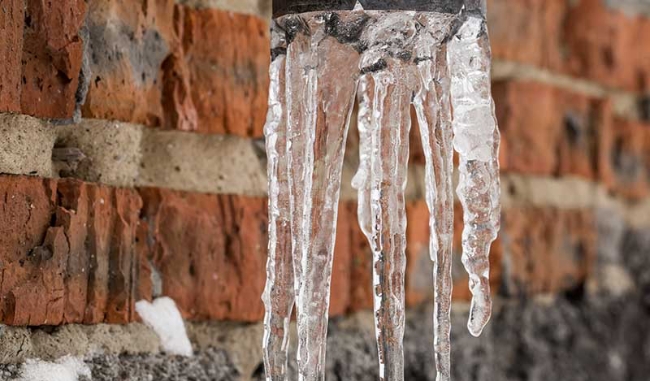Avoid Frozen Plumbing in Cold Weather: Pro Strategies
Avoid Frozen Plumbing in Cold Weather: Pro Strategies
Blog Article
The content down below involving How To Avoid Freezing Pipes is exceedingly insightful. Don't miss it.
:strip_icc()/snow-outdoor-faucet-pipes-4af65d1e5e904fb1aa7bf74071fe5d89.jpg)
Winter can ruin your pipes, especially by freezing pipes. Here's how to prevent it from taking place and what to do if it does.
Intro
As temperatures drop, the threat of icy pipes rises, potentially leading to costly repairs and water damages. Recognizing just how to prevent frozen pipelines is essential for property owners in chilly environments.
Understanding Frozen Pipelines
What triggers pipes to freeze?
Pipes ice up when subjected to temperatures below 32 ° F (0 ° C) for extended periods. As water inside the pipelines ices up, it broadens, putting pressure on the pipe walls and possibly triggering them to rupture.
Risks and problems
Icy pipelines can bring about water disturbances, property damages, and expensive repairs. Ruptured pipes can flooding homes and cause considerable structural damages.
Indications of Frozen Pipes
Determining icy pipes early can stop them from bursting.
How to determine icy pipes
Search for reduced water flow from faucets, unusual smells or noises from pipelines, and noticeable frost on subjected pipes.
Prevention Tips
Protecting prone pipelines
Wrap pipes in insulation sleeves or use warmth tape to shield them from freezing temperature levels. Focus on pipes in unheated or external areas of the home.
Home heating techniques
Keep interior rooms appropriately warmed, especially areas with plumbing. Open up closet doors to allow cozy air to circulate around pipelines under sinks.
Shielding Outdoor Pipes
Yard hoses and exterior taps
Disconnect and drain pipes yard hoses before wintertime. Install frost-proof spigots or cover outdoor faucets with protected caps.
What to Do If Your Pipes Freeze
Immediate activities to take
If you think frozen pipelines, keep faucets available to relieve pressure as the ice melts. Use a hairdryer or towels soaked in hot water to thaw pipes gradually.
Long-Term Solutions
Architectural adjustments
Think about rerouting pipes away from exterior walls or unheated areas. Include added insulation to attic rooms, cellars, and crawl spaces.
Updating insulation
Purchase top notch insulation for pipes, attics, and wall surfaces. Correct insulation assists preserve consistent temperatures and decreases the risk of frozen pipelines.
Final thought
Avoiding frozen pipes needs positive procedures and fast feedbacks. By recognizing the reasons, signs, and preventive measures, property owners can safeguard their pipes throughout winter.
5 Ways to Prevent Frozen Pipes
Drain Outdoor Faucets and Disconnect Hoses
First, close the shut-off valve that controls the flow of water in the pipe to your outdoor faucet. Then, head outside to disconnect and drain your hose and open the outdoor faucet to allow the water to completely drain out of the line. Turn off the faucet when done. Finally, head back to the shut-off valve and drain the remaining water inside the pipe into a bucket or container. Additionally, if you have a home irrigation system, you should consider hiring an expert to clear the system of water each year.
Insulate Pipes
One of the best and most cost-effective methods for preventing frozen water pipes is to wrap your pipes with insulation. This is especially important for areas in your home that aren’t exposed to heat, such as an attic. We suggest using foam sleeves, which can typically be found at your local hardware store.
Keep Heat Running at 65
Your pipes are located inside your walls, and the temperature there is much colder than the rest of the house. To prevent your pipes from freezing, The Insurance Information Institute suggests that you keep your home heated to at least 65 degrees, even when traveling. You may want to invest in smart devices that can keep an eye on the temperature in your home while you’re away.
Leave Water Dripping
Moving water — even a small trickle — can prevent ice from forming inside your pipes. When freezing temps are imminent, start a drip of water from all faucets that serve exposed pipes. Leaving a few faucets running will also help relieve pressure inside the pipes and help prevent a rupture if the water inside freezes.
Open Cupboard Doors
Warm your kitchen and bathroom pipes by opening cupboards and vanities. You should also leave your interior doors ajar to help warm air circulate evenly throughout your home.

I'm just very drawn to How to Prevent Your Pipes From Freezing and I am praying you liked the entire entry. If you enjoyed reading our page kindly don't forget to pass it around. We treasure your readership.
Suggested Site Report this page